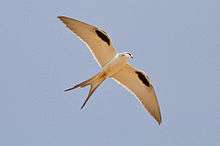Scissor-tailed kite
The scissor-tailed kite (Chelictinia riocourii), also known as African swallow-tailed kite or fork-tailed kite, is a bird of prey in the monotypic genus Chelictinia in the family Accipitridae.[2] It is widespread in the northern tropics of Africa.
| Scissor-tailed kite | |
|---|---|
 | |
| Flying in Far North Region, Cameroon | |
| Scientific classification | |
| Kingdom: | Animalia |
| Phylum: | Chordata |
| Class: | Aves |
| Order: | Accipitriformes |
| Family: | Accipitridae |
| Genus: | Chelictinia (Lesson, 1843) |
| Species: | C. riocourii |
| Binomial name | |
| Chelictinia riocourii (Vieillot, 1822) | |
| Synonyms | |
| |
Taxonomy and systematics
The species was illustrated in 1821 for a work by Coenraad Temminck, and described in 1822 by Louis Vieillot. It had been grouped with the Elanus kites or with the larger American swallow-tailed kite; in 1843 René Lesson assigned it to a separate genus, Chelictinia.[3]
The genus name Chelictinia is possibly derived from Greek χελιδών or χελιδονι (chelidon), the swallow,[4] with ικτινοσ (iktinos), the kite. The specific epithet riocourii honours the Count Rioucour, Antoine François du Bois "first president in the Royal Court of Nancy, and possessor of a beautiful collection of birds".[3][5] However, some sources refer to his son, Antoine Nicolas François, who was a contemporary of Vieillot.,[6][7]
Description
The scissor-tailed kite is a small, slim grey and white kite with a relatively weak bill, a broad head, long pointed wings and a deeply forked tail. The adults are generally pale grey above and white below, with a white forehead and a black patch around the eyes. In flight the dark greyish flight feathers contrast with the inner underwing edges, there is also an obvious black bar across the carpal. Juveniles are darker on the back with rufous edges to the feathers and creamier below. It has a distinctive almost tern like flight and frequently hovers into the wind like a kestrel. The red eyes of the adult are also a distinctive feature.[8]
Distribution and habitat
The species inhabits the arid savannah of the Sahel region of Africa, occurring mainly in a band between 8° and 15° N that stretches from Senegal on the west coast to Sudan in the east. There are also populations breeding in Ethiopia and Kenya.[9]"
It is found in many countries, including: Benin, Burkina Faso, Cameroon, Central African Republic, Chad, Ivory Coast, Djibouti, Eritrea, Ethiopia, Gambia, Ghana, Kenya, Liberia, Mali, Mauritania, Niger, Nigeria, Senegal, Somalia, Sudan, Togo, Uganda, and is also found in Yemen.[9]
Behaviour and ecology
When breeding the scissor-tailed kite feeds mainly on skinks and other lizards, as well as small snakes, rodents and arthropods. Usually hunts on the wing, dropping onto prey but does catch prey in flight, especially insects flushed by grass fires. When termites emerge or locust swarms there may be gatherings of scissor-tailed kites. Loose flocks have been known to associate with cattle, flying over the beasts and hawking any insects they flush.[8]
They breed in loose colonies of up to 20 pairs, although will do so as single pairs, mainly on May to August but breeds in December to February in the west and March- June or August in Kenya. A small stick nest is built an acacia or thorny bush at 2-8m from the ground. The nest is often sited close to the nest of a large raptor such as a secretary bird or a brown snake eagle, occasionally close to buildings.[8]
Status
The species is vulnerable to degradation of the habitat and pesticides. However, populations seem to be locally common in spite of decline in some parts of the range.[1]
References
| Wikimedia Commons has media related to Chelictinia riocourii. |
- "Chlictinia riocourii". IUCN Red List of Threatened Species. Retrieved 28 October 2016.
- "ITIS Report: Chelictinia". Integrated Taxonomic Information System. Retrieved 19 September 2014.
- Temminck, C. J. (Coenraad Jacob) (1824). "Milan Riocour". Nouveau recueil de planches coloriées d'oiseaux, vol. 1.
M. Vieillot a dédié cette espèce à M. le comte de Riocour, premier président en la Cour royale de Nanci, et possesseur d'une belle collection d'oiseaux.
- Thompson, D'Arcy Wentworth (1895). "Χελιδών". A Glossary of Greek Birds. Oxford: Clarendon Press. p. 186.
- "Antoine François du Boys de Riocour". Geneanet. Retrieved 27 April 2016.
Conseiller d'Etat du roi de Pologne et 1er président de la Chambre des comptes de Lorraine
The surname du Boys is also written as du Bois or Dubois. - Jobling, James A. (2010). The Helm Dictionary of Scientific Bird Names. London: Christopher Helm. p. 336. ISBN 978-1-4081-2501-4.
- Lesson, René Primevère (12 January 1843). "Index Ornithologique par Lesson". l'Echo du Monde Savant. Year 10, no. 3, column 60–63.
- Ferguson-Lees, James; Christie, David A. (2001). Raptors of the World. Christopher Helm. p. 449. ISBN 0-7136-8026-1.
- BirdLife International. "Species factsheet: Chelictinia riocourii".
